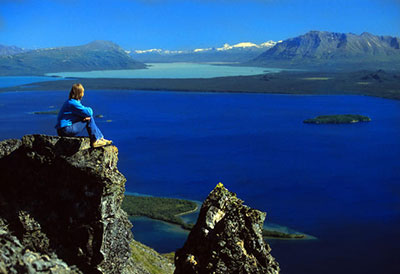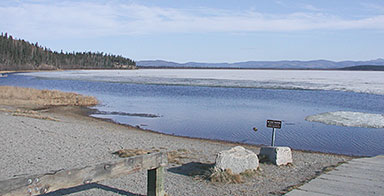Alaska Fish & Wildlife News
May 2014
Lake Turnover
How Sinking Water Rejuvenates Alaska Lakes

One of the most interesting properties of water is that it is less dense as a solid (ice) than it is as a liquid. This is the property that causes ice to float rather than sink. If water did not have this property, life, as we know it, would not be able to exist. If water acted like most other liquids, during winter, lakes would continuously form ice on the surface. The ice would sink to the bottom and more ice would form and sink until lakes were solid ice blocks. However, because ice floats, it essentially caps the lake and though ice continues to form throughout winter, it does so slowly because the ice itself acts as a buffer between the frigid air temperatures and the lake water.
Water is most dense at 39 degrees Fahrenheit (4 degrees Centigrade). Water that is either warmer or colder than 39 degrees F (4 degrees C) is lighter than water at that precise temperature. This characteristic is what causes “turnover” in our lakes every spring and every fall.
In the fall, colder air temperatures chill the surface waters of our lakes until the water high in the water column becomes heavier than the water underlying it. The surface water sinks and the underlying warmer water rises until the entire lake has “turned over.” Once the lake has turned over and water is at a relatively equal density, ice will begin to form.

In the spring as the ice melts, the same thing occurs, except that the surface waters warm and become more dense than the underlying cold water. That warmer water sinks and the colder water rises to the top to be warmed until the entire lake has turned over once again.
Lake turnover mixes the lake water, distributing nutrients from the bottom upward and oxygen from the surface downward. This turnover of nutrients and oxygen is highly beneficial to the health of the lake and its aquatic inhabitants, as well as for the people and other critters that depend upon the lakes for food and water.
In just a few weeks, the ice will be off of most Alaska’s lakes. The lakes will go through spring turnover. Though not at all as flashy as the arrival of the plethora of ducks and geese filling the air with a cacophony of quacking and honking, lake turnover is a silent, sure indicator that spring is here and summer is not far behind.
Subscribe to be notified about new issues
Receive a monthly notice about new issues and articles.
